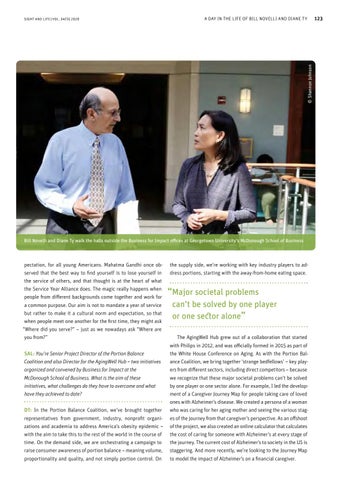A DAY IN THE LIFE OF BILL NOVELLI AND DIANE TY
© Shannon Johnson
SIGHT AND L IFE | VOL. 34(1) | 2020
Bill Novelli and Diane Ty walk the halls outside the Business for Impact offices at Georgetown University’s McDonough School of Business
pectation, for all young Americans. Mahatma Gandhi once observed that the best way to find yourself is to lose yourself in the service of others, and that thought is at the heart of what the Service Year Alliance does. The magic really happens when people from different backgrounds come together and work for a common purpose. Our aim is not to mandate a year of service but rather to make it a cultural norm and expectation, so that when people meet one another for the first time, they might ask “Where did you serve?” – just as we nowadays ask “Where are you from?” SAL: You’re Senior Project Director of the Portion Balance Coalition and also Director for the AgingWell Hub – two initiatives organized and convened by Business for Impact at the McDonough School of Business. What is the aim of these initiatives, what challenges do they have to overcome and what have they achieved to date? DT: In the Portion Balance Coalition, we’ve brought together representatives from government, industry, nonprofit organizations and academia to address America’s obesity epidemic – with the aim to take this to the rest of the world in the course of time. On the demand side, we are orchestrating a campaign to raise consumer awareness of portion balance – meaning volume, proportionality and quality, and not simply portion control. On
the supply side, we’re working with key industry players to address portions, starting with the away-from-home eating space.
“Major societal problems can’t be solved by one player or one sector alone” The AgingWell Hub grew out of a collaboration that started with Philips in 2012, and was officially formed in 2015 as part of the White House Conference on Aging. As with the Portion Balance Coalition, we bring together ‘strange bedfellows’ – key players from different sectors, including direct competitors – because we recognize that these major societal problems can’t be solved by one player or one sector alone. For example, I led the development of a Caregiver Journey Map for people taking care of loved ones with Alzheimer’s disease. We created a persona of a woman who was caring for her aging mother and seeing the various stages of the journey from that caregiver’s perspective. As an offshoot of the project, we also created an online calculator that calculates the cost of caring for someone with Alzheimer’s at every stage of the journey. The current cost of Alzheimer’s to society in the US is staggering. And more recently, we’re looking to the Journey Map to model the impact of Alzheimer’s on a financial caregiver.
123


























